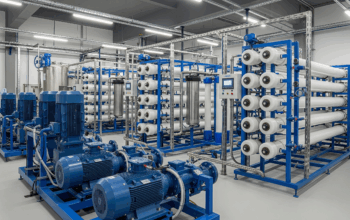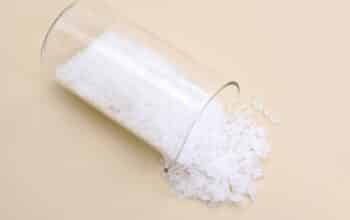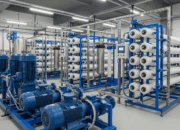Waterjet cutting is a cold-cutting technology that uses a high-pressure stream of water—sometimes mixed with abrasive materials—to slice through a wide range of materials without heat or chemicals.
In today’s world, sustainable manufacturing isn’t just a competitive edge—it’s a mandate. Governments, clients, and consumers are all pressing for cleaner, more resource-efficient production. Manufacturers are responding, but many face a dilemma: how do you reduce environmental impact without compromising on speed, precision, or flexibility?
That’s where waterjet cutting stands out. Unlike traditional subtractive methods, waterjet systems deliver exceptional accuracy while using less energy, generating minimal waste, and requiring no harmful emissions.
According to Precedence Research, the global green manufacturing market is projected to reach over $1.3 trillion by 2032, growing at a CAGR of 10.5%. Within this shift, waterjet cutting is carving out its role as a sustainable, scalable solution for modern shops.
In this guide, we’ll explore how waterjet cutting can help manufacturers go green without compromising on accuracy or performance.
What makes waterjet cutting a sustainable technology?
Unlike laser or plasma systems, waterjet cutting operates at ambient temperatures and doesn’t distort materials. It’s a cold-cutting process that separates material mechanically, not thermally. That simple distinction leads to big environmental advantages.
Here’s what makes it stand out:
- No hazardous fumes or gases
There’s no combustion, melting, or toxic byproducts released into the air. - No heat-affected zones
Material structure stays intact, allowing for reuse, recycling, and minimal warping. - Minimal waste production
Tight tolerances and precise jet paths reduce offcuts and scrap. - Ability to recycle cutting water
Closed-loop water systems filter and reuse water repeatedly, minimizing freshwater use. - Cuts without added chemicals
No acids, resins, or binding agents are involved—just pressurized water and abrasive.
On top of the environmental benefits, waterjet technology often helps companies comply with tightening regulations. Lower air pollution, safer shop conditions, and reduced waste output make it easier to meet standards like ISO 14001 and local EPA guidelines.
How does waterjet cutting actually work?
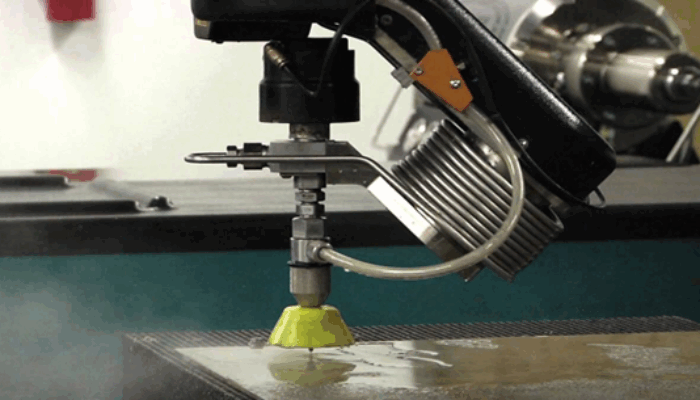
Waterjet cutting might look simple on the surface, but under the hood, it’s a highly engineered process involving precise control of pressure, flow, and motion.
Here’s a breakdown of how it works:
- Pressurizing water (up to 60,000–90,000 psi)
High-pressure pumps force water through a small orifice, creating a razor-sharp stream. - Introducing abrasive material (e.g., garnet)
For cutting harder materials, fine abrasive particles are injected into the jet stream. - Controlling cutting head via CNC software
CNC programming determines movement, feed rate, and cutting path with micrometer precision. - Cutting the material using pure or abrasive jets
Soft materials use pure water; metals and stone typically require abrasives.
There are two main types of pump systems: intensifier pumps, which use hydraulic pressure to compress water, and direct drive pumps, which are more efficient for lower-pressure, high-frequency cuts.
Material characteristics—such as hardness, thickness, and layering—determine key parameters like orifice size, jet velocity, and cutting time. Softer plastics may require minimal pressure, while dense titanium demands a precise balance of pressure and abrasive concentration.
What materials can be cut using waterjet technology?
One of the strongest arguments for waterjet cutting in sustainable manufacturing is its material versatility. It cuts virtually anything without producing secondary waste streams like dust, heat zones, or burnt edges.
Here’s a closer look:
- Metals (steel, aluminum, titanium, copper, etc.)
Ideal for aerospace, automotive, and industrial components. All fully recyclable. - Stone (granite, marble)
Often used in architecture. No thermal cracking ensures offcuts can be reused. - Glass and ceramics
No risk of shattering from heat—waterjet cuts cleanly through delicate materials. - Composites (carbon fiber, G10)
Efficient for trimming high-performance parts without delamination or resin damage. - Plastics and rubbers
No melting means no toxic fumes. Clean cuts preserve material integrity. - Wood and laminates
Perfect for design, furniture, and reuse projects. No charred edges, no sawdust waste.
All of these materials can be reused or recycled after cutting, making waterjet an attractive option for circular production workflows.
Is waterjet cutting really precise enough for high-end manufacturing?
Absolutely. Waterjet cutting systems regularly achieve tolerances of ±0.1 mm, making them competitive with laser and EDM solutions—without the downsides of heat or slow speed.
Several factors influence the final precision:
- Nozzle wear
Over time, orifice size can change, slightly affecting cut quality. - Table rigidity
A solid, vibration-free bed ensures consistent depth and direction. - Type of abrasive
Finer abrasives like mesh 80–120 deliver cleaner, narrower kerfs. - Operator calibration
Regular maintenance and alignment checks keep systems at peak performance.
Industries like aerospace, electronics, and medical devices already rely on waterjet systems to deliver cuts with minimal deviation, high repeatability, and excellent edge quality—without introducing heat that could compromise sensitive materials.
How does waterjet cutting compare to other cutting technologies in sustainability?
While waterjet isn’t the fastest or cheapest cutting method, it often leads in environmental performance. Here’s how it stacks up:
- Laser cutting Requires high energy input and produces fumes. Limited on thicker materials.
- Plasma cutting
Fast and effective but generates heat zones, toxic gases, and heavy slag. - CNC routing
Creates large amounts of dust and suffers from tool wear and breakage. - EDM (electrical discharge machining)
Extremely precise but limited to conductive materials and slower overall.
Waterjet cutting shines where clean edges, no heat, and low environmental impact are top priorities. It may not replace all tools, but in many green manufacturing workflows, it’s becoming the method of choice.
What are the core components of a sustainable waterjet cutting system?
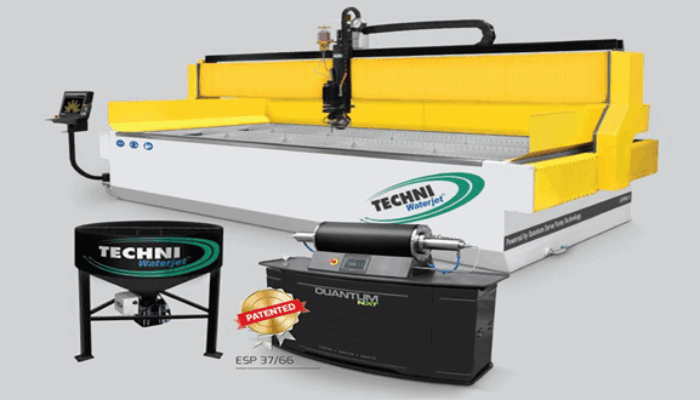
A truly green waterjet setup isn’t just about the cutting—it’s about how every component contributes to lower waste and smarter resource use. Here are the essentials:
- High-pressure pump
The engine of the system, responsible for maintaining cutting pressure. Energy-efficient models reduce electricity costs. - Cutting head/nozzle
Designed for precision and low wear, helping maintain tight tolerances over time. - Abrasive feed system
Controls flow of abrasive material; some systems include sensors to prevent overuse. - Catcher tank
Captures used water and abrasive for separation and potential recycling. - CNC controller
Optimizes cutting paths to minimize overcutting and reduce scrap. - Filtration and recycling units
Closed-loop water systems that filter sediment, skim oil, and recirculate clean water.
Each part plays a role in conserving resources and minimizing shop waste. Together, they form the backbone of sustainable cutting operations.
How is water managed and recycled in green waterjet cutting setups?
Water usage is one of the most critical concerns in sustainable waterjet operations. Fortunately, modern systems offer effective recycling strategies.
There are two approaches:
- Closed-loop systems recirculate water through filtration and purification stages, reducing total consumption.
- Open-loop systems discharge used water, requiring treatment before reuse or disposal.
In a closed-loop system, filtration often includes:
- Sediment separation – removes heavy particles like spent abrasive
- Oil skimmers – eliminate tramp oils from cutting processes
- Reverse osmosis (optional) – provides purified water to extend equipment life
On average, a single cut may use 0.5 to 1 gallon per minute, but up to 90% of that water can be recycled in well-maintained systems, drastically reducing environmental impact.
How much abrasive is used—and can it be reused?
Abrasive material, especially garnet, accounts for much of the waste in waterjet cutting. Usage ranges from 0.5 to 1.5 pounds per minute, depending on material and pressure settings.
Common abrasives include:
- Garnet – widely used, natural mineral, relatively low dust
- Olivine – less common, softer, often chosen for delicate work
While abrasives are typically single-use, some shops use recycling systems based on:
- Mechanical separation – screens and classifiers to remove fines
- Magnetic separation – pulls out ferrous contaminants
Still, reusing abrasive may reduce cutting performance. Here’s a quick breakdown:
Pros:
- Cuts down disposal volume
- Saves on material costs
- Reduces mining demand
Cons:
- May degrade cut quality
- Requires extra equipment and floor space
- Can lead to nozzle wear
What industries are using waterjet cutting to meet green goals?
More sectors are turning to waterjet to meet emission targets, reduce scrap, and boost recyclability.
- Aerospace: Cuts titanium, composites with no heat distortion
- Automotive: Shapes EV battery housings and lightweight aluminum parts
- Construction: Fabricates green panels and cuts recycled stone
- Electronics: Rapid-prototyping PCBs without chemicals
- Medical: Produces surgical-grade stainless tools and implants
- Furniture & design: Works with reclaimed wood and eco-plastics
Each example shows how waterjet aligns with specific sustainability objectives—precision, clean cuts, and minimal waste.
Does waterjet cutting support circular manufacturing?

Circular manufacturing emphasizes reuse, recycling, and minimizing input. Waterjet technology fits naturally into this model.
It enables:
- Clean cutting of recyclable materials
- Minimal offcuts, which can be reused
- No thermal distortion, making scrap suitable for reintegration
Shops aiming for zero-waste workflows can combine waterjet cutting with:
- Recycled stock materials
- Inventory tracking for offcut reuse
- On-site abrasive and water recycling systems
What design practices make waterjet cutting even greener?
Designing with sustainability in mind enhances the green potential of waterjet systems. Best practices include:
- Nesting parts to reduce waste
- Avoiding sharp internal corners (which slow down the cut and increase wear)
- Choosing recyclable stock materials
- Minimizing overcutting via CAM optimization
Pairing intelligent CAD/CAM software with smart design decisions helps reduce raw material use and lower operational costs.
What are the key limitations or challenges of waterjet cutting in green manufacturing?
Despite its benefits, waterjet cutting has drawbacks that manufacturers should address:
- High energy demand for pressurization
- Abrasive waste is non-biodegradable
- Slower than plasma or laser for thin materials
- Noisy operation can require additional mitigation
Solutions include:
- Using energy-efficient pumps
- Implementing abrasive recycling systems
- Installing sound enclosures
- Scheduling cuts to consolidate high-pressure use
What should you look for in a sustainable waterjet cutting machine?
When selecting a system, look for:
- Energy-efficient pump systems
- Abrasive recycling integration
- Water filtration and reuse systems
- Remote monitoring and diagnostics
- Durable, low-maintenance components
Each feature helps reduce resource use, increase machine uptime, and support a long-term sustainability strategy.
How can waterjet cutting help companies meet environmental certifications?
Waterjet systems help align with:
- ISO 14001 – Environmental management
- LEED – Credits for cleaner manufacturing
- EPA Safer Choice – Non-toxic process validation
Steps to align with green compliance:
- Document water and abrasive use
- Track waste volumes
- Maintain preventive maintenance logs
- Train teams in eco-conscious standard procedures
These steps not only improve compliance but often lead to cost savings and better workplace safety.
Conclusion
Waterjet cutting offers an uncommon combination: high-precision performance with low environmental impact. It skips the heat, skips the fumes, and still delivers clean, accurate cuts across a vast range of materials.


